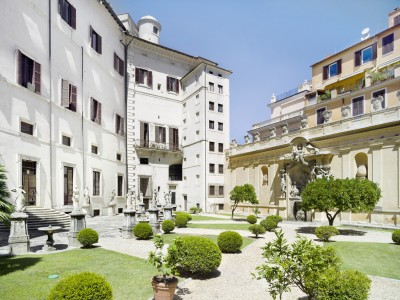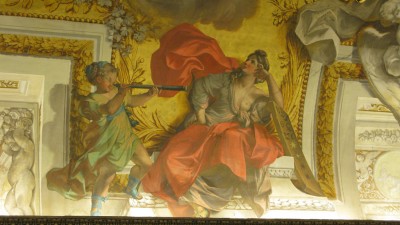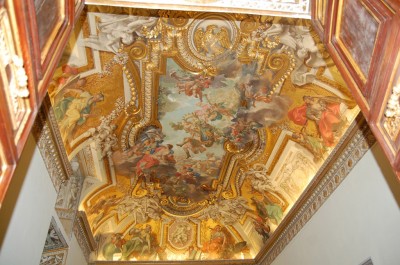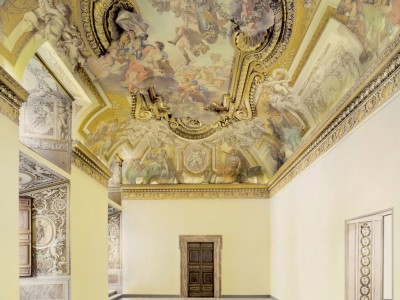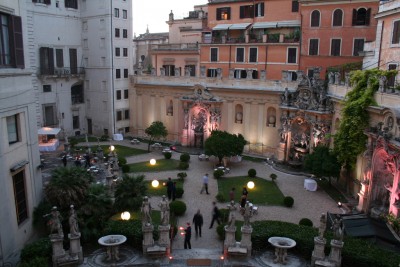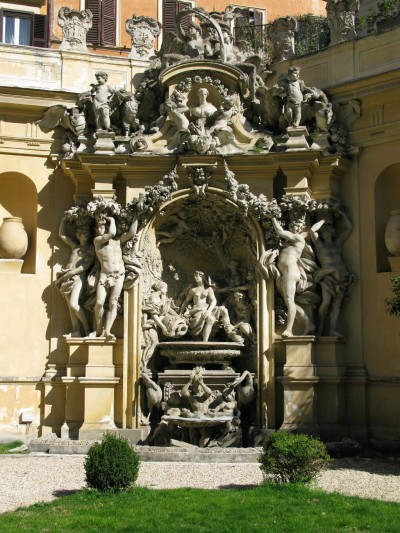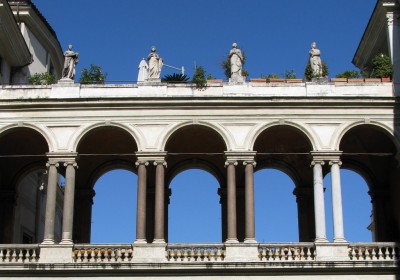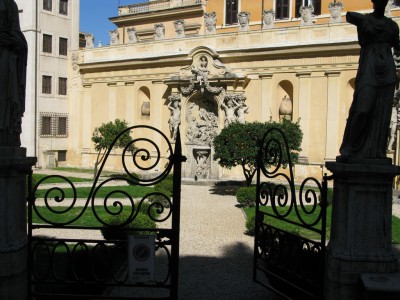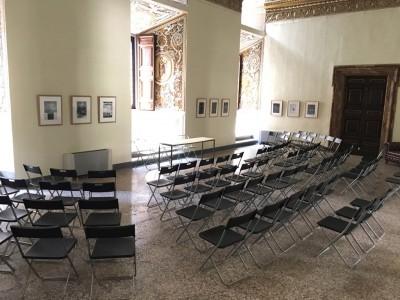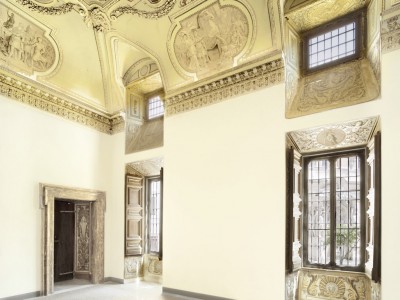Contact the abode
GALLERIA DEL CEMBALO – PALAZZO BORGHESE IN ROME
Galleria del Cembalo occupies part of what was the ‘Galleria Terrena’ ground floor of Palazzo Borghese in the 18th century, overlooking a nymphaeum with magnificent fountains designed by Carlo Rainaldi, which over time has become an exhibition space displaying the Borghese family's private collection of paintings and sculptures. Today, it is an ideal setting for art exhibitions, private events and conferences.
After crossing the courtyard of the Palazzo, visitors walk through the garden to enter the gallery, accentuated by neatly manicured green spaces and small bushes, and the crowning glory of the fountains, which are operational in fine weather and add the gentle sound of water to the general atmosphere of peace and tranquillity. A polychromatic mosaic surrounds the semi-circular staircase leading to the gallery, which is on a raised level above the green area.
Of the original Galleria Terrena, Galleria del Cembalo occupies five large communicating rooms, three of which overlook the nymphaeum, with very high ceilings decorated with frescoes and golden stuccoes.
The first room is dedicated to Aurora, who is depicted in the throes of scattering flowers into the sky at daybreak in the large ceiling painting by Francesco Caccianiga (1773). The painting has an opulent gilded wooden frame, with the family's heraldic symbols of an eagle and a dragon at both ends, reinforcing the fact that the Borghese family experienced a revival during that period under the leadership of the head of the family, Marcantonio IV.
The ‘Sala dell'Aurora’ leads into what was then known as the ‘Sala dell'Udienza’ or Audience Room, where the Prince used to receive guests during the Grand Tour. This room is crowned by a rich fresco representing 'The Triumph of the House of Borghese’, painted by Ermenegildo Costantini (1767-1774), featuring the family coat of arms carried in glory by rejoicing cherubs. It displays a profusion of gold and three-dimensional effects created with stucco on the wooden frames.
The Audience Room is the centrepiece of the gallery and is also the largest space for hosting guests, either for assemblies or presentations, as well as private events.
On the side facing Piazza Borghese stands the 'Sala di Ebe’, also known as the Hall of Hebe. This hall is marked by the dominant presence of 'Hebe Abducted by Time’, a Baroque masterpiece by Ermenegildo Costantini and Pietro Rotati (1769). In this composition, the goddess of youth, Hebe, is shown being abducted by Time, a dynamic scene that bears a striking resemblance to Gian Lorenzo Bernini's 'Rape of Proserpina’.
The Cupid Room, which originally served as the Princess's antechamber, exemplifies a meticulous neo-Classical decor crafted by French artist Laurent Pécheux. His signature, alongside the date of 1774, graces the base of one of the wall frescoes. At the heart of the vaulted ceiling is a captivating painting depicting 'The Wedding of Cupid and Psyche’, while adorning the walls flanking the vault are scenes portraying the moments preceding the wedding, with Mercury taking on the role of the messenger of love.
The final room with a view of the garden and a vantage point facing the Tiber River is the one dedicated to Minerva, which is said to have once contained the renowned statue of Hermaphrodite, now part of the Villa Borghese collection. On the ceiling is a painting by Pietro Angeletti (1773) illustrating 'The Reconciliation of Venus and Minerva’. On the sides of the vault, there are monochrome panels by Agapito Vitti showing pivotal scenes from the Trojan War, where the goddesses took opposing stances: the duel between Paris and Menelaus, Ulysses and Diomedes, Hector and Venus, and the Trojan horse.
THE HISTORY OF GALLERIA DEL CEMBALO – PALAZZO BORGHESE
The history of Galleria del Cembalo is, naturally, inseparable from that of Palazzo Borghese and was constructed between 1605 and 1676 by incorporating pre-existing residential structures. Like many of the Palazzos constructed in Rome, this complex saw the involvement of several renowned architects across different phases of its development, culminating in the grand structure we observe today. Its distinctive, irregular form extending toward the river inspired the building’s nickname of ‘Cembalo’, or harpsichord. As Giuseppe Antonio Guattani wrote in his work on Rome entitled ‘Roma descritta e illustrata’ in 1805, “Hence it is said by the common people that the four wonders of Rome are the Farnese dice, the Borghese harpsichord, the Caetani staircase and the Carboniani gate”, referring to the square shape of Palazzo Farnese, the Caetani staircase at Palazzo Ruspoli and the doorway of Palazzo Sciarra-Colonna.
The first and oldest nucleus of the Palazzo is situated at Largo della Fontanella di Borghese. It originally began as a palazzetto designed by Il Vignola and constructed by Tommaso del Giglio in 1590. This property was later acquired by Cardinal Deza, who commissioned its expansion, first to Martino Longhi the Elder and subsequently to Flaminio Ponzio. The heraldic symbols of the Deza and Giglio families still adorn the archivolts of the courtyard near the entrance, bearing witness to their historical association with the building. Following the acquisition of the property by Cardinal Camillo Borghese, who would later become Pope Paul V, renovations continued until 1613. In the years that followed, it underwent further enhancements by notable architects such as Carlo Maderno, Giovanni Vasanzio (1670) and Carlo Rainaldi.
Over time, Galleria Terrena assumed a dual role as both a reception space for visitors and a showcase for the growing collection of artworks curated by Pope Paul V, aimed at elevating both the family's prestige and the Palazzo's reputation. This endeavour was largely attributed to the discerning taste and expertise of his nephew, Cardinal Scipione. Reflecting a prevalent practice among the prominent Palazzos of the era, the ground floor was designated as a reception area, independent from the residential quarters, ensuring that visitors could be welcomed without encroaching upon the private lives of the its residents.
For over two centuries, the Borghese collection graced twelve rooms on the ground floor, welcoming travelers on the Grand Tour who were hosted by the Prince and Princess. In this regard, Palazzo Borghese vied for attention with the other distinguished residences belonging to the city's patrician families. These rooms held a treasure trove of artworks by renowned artists like Raphael, Domenichino, Andrea del Sarto, Lorenzo Lotto, Van Dyck, Correggio and Titian, to name just a few. However, this role as an exhibition gallery was eventually to be superseded and replaced by the villa on Pincian Hill, now known as Galleria Borghese. Built between 1608 and 1613 with the express purpose of housing the collection, it underwent redecoration in the mid-18th-century, with each room's style tailored to complement the artworks it contained.
The frescoes on the vaults of Galleria del Cembalo were the result of a new decorative cycle commissioned by the head of the family in the mid-18th century, Marcantonio IV, the son of Agnese Colonna, in preparation for his marriage to Anna Maria Salviati (1775).
The interconnected rooms constituted the private apartments of the Prince and Princess, with his rooms overlooking the exterior and hers featuring windows facing the hidden garden. It seems unlikely that these rooms were actually used as living quarters, except perhaps partially during the warmer months.
While all the rooms have exceptionally high frescoed ceilings enriched by ornate wooden frames with intricate gilded stucco work, each space has its own individual style, drawing inspiration from the painting that commands the centre of the vault. For instance, there is a distinctly neo-Classical room that was crafted by French artist Laurent Pécheux in 1774. Another showcases 'The Triumph of the House of Borghese and the Arts’ fresco by Ermenegildo Costantini from 1767. This particular artwork has been hailed by art critics as 'the final flourish of Roman Baroque’, as it constitutes a direct homage to the ceiling of the Church of the Gesù, painted by Baciccio (Giovan Battista Gaulli) a century earlier.
Large original wooden doors with rare alabaster frames connect the rooms, all of which enjoy views of the tranquil garden and fountains.
FACILITIES AND SERVICES: PRIVATE EVENTS IN ROME
The Galleria del Cembalo is presently dedicated to curating 'fine art' photography exhibitions. The gallery operates with full autonomy in programming and artist selection, actively promoting both Italian and international artists while also participating in specialised art fairs.
The rooms can be reserved for one or multiple days to host private events, art exhibitions or business meetings that may necessitate different spaces to accommodate distinct groups or activities. For this purpose, the gallery is equipped with 100 conference chairs, several consoles, an 80'' TV screen and an amplification system with microphones.
External catering services are available for business lunches or refreshments during corporate meetings. Upon request, it is possible to organise refreshments outdoors in the nymphaeum area, subject to authorisation by the Palazzo Borghese condominium.
